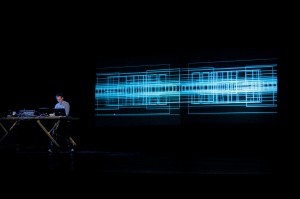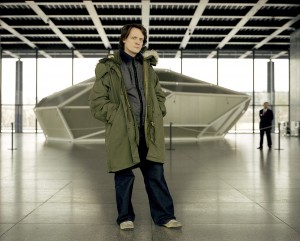The work of German artist Carsten Nicolai encompasses electronic sound/music performance and mixed media installation. Born in Karl Marx Stadt (now Chemnitz), Germany in 1965, and initially trained as a landscape architect, his practice integrates elements of computer manipulated audio, video, and sculpture, frequently drawing influence from the physics of phenomena introduced into his work via oscillators, test equipment, reactive objects and media. Nicolai’s history in landscape architecture and design can thus be seen to strongly permeate his work in its focus on form, structure, recursion and the underlying dynamics of natural and scientific phenomena. As Christopher Cox suggests, “Nicolai reminds us that all matter is creative vibration”[1].
His musical work, released under the pseudonym alva noto, or simply noto, has been widely published by the raster-noton label[2]. The label was formed in 1999 from the merger of the artist run label rastermusic, founded by Olaf Bender and Frank Bretschneider to publish work influenced by minimal techno and minimalist electronic pop, and Nicolai’s noton archiv für ton und nichtton, which focused on experimental sound and art/science projects.

Transform, alva noto, audio visuals live, 2003. Photo: Anna Van Kooij
Such a crossover between the conceptual end of popular music and the ‘non-academic’ end of experimental music practices has been a strong trend of the last decade where notions of high art and popular culture become increasingly irrelevant, especially to those artists from Generation X and Y. As a consequence, many of these artists embrace developments in DJ culture and intelligent dance music (idm) culture and consider them to be as relevant as the canon of western high art (in some cases, more so). Certainly Nicolai’s music bears the hallmarks of an engagement with electronic dance music via its use of pulse, regular bpms and meter. The 2000 Mille Plateaux release Prototypes exemplifies this via its starkly beautiful beatscapes made up of small digital clicks, pops and glitches and ultra-high pulsing textures, combined with the most minimal of grainy, tuned materials which allude to a harmonic and melodic background, never fully coming into sharp focus. While the sound world is extreme in its register and exaggerated thin-ness of texture, the familiar language of the beat is never far from the surface, playing a critical role in structuring the compositions throughout. On the earlier Plate Lunch Records release Kerne (1998); Nicolai creates 18 different pieces from 18 different waveforms that, while foregrounding pulse, is a more abstract set of earlier experiments in this sound world, demanding closer, more sustained attention from the listener.
Nicolai is located along with others such as Ryoji Ikeda from Japan and Mika Vainio from Finland (from the duo Pan Sonic) as one of the early influential figures of ‘post-digital’ music in the mid- to late 1990s, which has since been the dominant aesthetic in recent electronic and experimental music. The term ‘post-digital’ was first coined by electronic music artist and theorist Kim Cascone in his article ‘The Aesthetics of Failure: Post-Digital Tendencies in Contemporary Computer Music’[3] to describe an emerging aesthetic which embraced an obsession with the potential musical applications of test signals, damaged audio, the ‘abuse’ of digital tools, microsonic structures, system noise, digital artefacts and, most important of all, the system error or ‘glitch’. As such, it presents a critique of the once dominant view of digital space as pristine, uncoloured, and stable. Rather contentiously, Cascone has argued that in recent electronic music “the medium is no longer the message, the tool has become the message” (see footnote 3). Opinions on the viability of this argument vary, but regardless, this focus on ruptures and errors in otherwise regular formal structures has been a continuing interest in Nicolai’s work, as it has been in many others.
Beyond the immediate sphere of post-digital music (although arguably overlapping to a great degree) Nicolai, along with a number of artists from the minimal techno scene, could be said to have been one of the key figures in driving a renewed interest in minimalist aesthetics and processes in the electronic music scene over the last decade. Although heavily influenced by digital aesthetics, such an interest in process, perception and phenomena has its roots in the experimental ‘perceptual’ minimalism of the 1960s and the work of key figures such as Alvin Lucier, La Monte Young and Phill Niblock, along with ‘pattern-based’, or ‘repetitionist’ minimalism as exemplified by Steve Reich, Terry Reilly and Philip Glass. Building on existing concepts of both perceptual and pattern-based minimalism, ‘digital minimalism’ (as manifested in minimal techno and post-digital music) leverages the angular and formal structures (lines of code, quantised shapes, square pixels, the dot matrix, video compression block artifacts etc.) associated with the underlying operation of digital technologies, finding its most succinct manifestation in the 0 and 1 formalism of binary code.
Nicolai has collaborated widely (as alva noto) with other musicians, including the prominent Japanese musician Ryoji Ikeda. Together, under the name Cyclo, they examine error structures, repetitive loops and micro-editing, and the creation of real-time visualizations via meters and software intended for signal metering and equipment calibration. This creates an ambiguity where audio and video become both drivers and artefacts of the shapes and structures created throughout the work. Local musician Robin Fox has explored similar concepts in his work Backscatter (2004) where a cathode ray oscilloscope is used to visualise sonic materials, but where the audio may become subservient to rendering the desired visual material. The use of test equipment has strong historical references to early electronic music practices of the 1950s where such devices were used to make music in specialised ‘labs’ prior to the design and availability of dedicated ‘instruments’. The art-science trope is thus a rich and constantly evolving one in the field of electronic music.
Nicolai’s solo performance and installation work fluidly crosses and blurs the audio-visual divide. In performance, this is commonly delivered via two laptops, where audio and images share synchronous processes and swap data streams, resulting in outcomes that take on a powerful quality of synaesthesia. Recurring themes and techniques in both performance and installation works are the visualisation of audio signals from oscillators (taking the output of an oscillator and presenting it as a video signal to a monitor or projector) and the sonification of video signals. In the installation piece Telefunken: audiosignal for television set (2000), audio signals from a CD player are ‘erroneously’ fed to the video inputs of a Sony Trinitron television. Lines, geometric figures, and a range of abstract video textures are produced from carefully controlled audio waveforms and frequencies on an Audio CD. Tracks 1-20 of the CD are collectively entitled impulse to line, while 21-30 are entitled testtones. The intimate relationship between sound, image and space has been an ongoing interest for Nicolai, “sound is a frequency and can thus be defined in spatial terms. In this way, phenomena such as sound and space are physically interwoven”[4].

photo courtesy of Carsten Nicolai
Nicolai has indicated an interest in ‘self-organising processes’, where an artist creates a set of pre-conditions and allows for continuing processes to form the outcomes and detail of the work. Such an interest is foregrounded in his installations and, most notably, in a piece such as Snow Noise (2001). This work is inspired by the research of physicist Ukichiro Nakaya, who studied the formation of snow crystals, eventually classifying 79 broad categories of crystals and a number of anomalous forms, which he called ‘mavericks’. At around this time, Nicolai also become familiar with the work of a-life researchers Takashi Ikegami and Takashi Hashimoto, who studied loop structures and self-organisation, “loops…generate errors and thus form certain patterns…[which] are at a later point in time examined to see whether they have a specific intrinsic logic”[5]. In Snow Noise, a lab-like array of acrylic and copper tubes fitted to polystyrene boxes and magnifying glasses forms a system to make snow crystals, accompanied, at the periphery of the room, by diagrams of crystal formations and an audioscape. The viewer can thus experience the complex growth of snow crystals over time in the context of a subtle, phenomena-based artwork.
Julian Knowles
Julian Knowles is a composer/performer and sound designer who utilises new technologies. He has worked nationally and internationally in a variety of contexts such as performance, intermedia collaborations, film and television, and other project. He is currently Head of the School of Music & Drama at the University of Wollongong.
References
[1] Christopher Cox, From Synapse to Signal: Carsten Nicolai’s ‘telefunken’ in Carsten Nicolai Autopilot. Berlin: Die Gestalten Verlag, 2002 pp.14-17
[2] http://www.raster-noton.net/
[3] Kim Cascone, The Aesthetics of Failure: Post Digital Tendencies in Contemporary Computer Music. Computer Music Journal, 24:4 2000 pp.12-18
[4] Carsten Nicolai Autopilot. Berlin: Die Gestalten Verlag, 2002 p.80
[5] Carsten Nicolai Autopilot. Berlin: Die Gestalten Verlag, 2002 pp.27-76
Read More
http://www.alvanoto.com/
Watch More
 This work is licensed under a Creative Commons Attribution-NonCommercial-ShareAlike 3.0 Australia.
This work is licensed under a Creative Commons Attribution-NonCommercial-ShareAlike 3.0 Australia.






